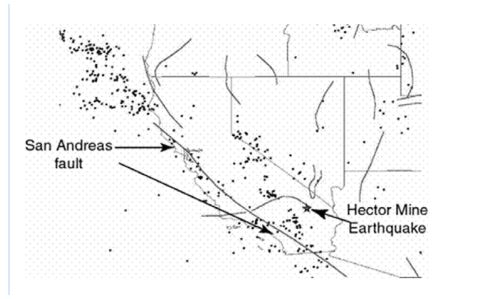Multiple Choice
Read the following exert from a USGS report concerning a recent earthquake and answer this question.
Special Report: The Hector Mine Earthquake, 10/16/1999
A M7.1 earthquake occurred at 2:46 a.m. local time on 10/16/1999.
The event was located in a remote, sparsely-populated part of the Mojave Desert of California,
approximately 47 miles east-southeast of Barstow and 32 miles north of Joshua Tree (see map next page) .
The initial magnitude estimate of 7.0 was upgraded to 7.1 on October 18, 1999, based on in-depth analysis
of "teleseismic" data recorded worldwide.
The earthquake occurred on the Lavic Lake fault, one of a series of north-northwest trending faults
through the eastern Mojave shear zone. Geologists from the U.S. Geological Survey and Southern
California Earthquake Center were able to fly over the rupture (which is within the Twenty Nine Palms
Marine Base) on the afternoon of October 16 and documented a 40-km long surface rupture. The aerial
photos show an apparent maximum offset of 3.8-4.7 meters. These preliminary estimates for both fault
length and slip are consistent with expectations for a magnitude 7.0 earthquake, although the slip is
perhaps somewhat larger than average. The fault is one of a series of closely spaced, northwest-trending,
right-lateral strike slip faults that traverse this portion of the Mojave Desert. Together, these faults within
what is termed the Mojave Shear Zone serve to relieve a small portion of the stresses that build up along
the boundary between the Pacific and North American tectonic plates.
An interesting aspect of the Hector Mine earthquake is that it occurred only 7 years after the 1992 Landers
and Joshua Tree earthquakes, which occurred on similar faults within the Mojave Shear Zone. This
apparent clustering of earthquakes may be purely coincidental, but scientists are conducting research to
see if this kind of earthquake behavior is typical of this region. That is, perhaps many of the Mojave Shear
Zone faults produce earthquakes within a short time interval (perhaps spanning several hundred or more
years) , followed by several thousands of years of quiescence.

-What is the current hypothesis scientists are investigating with regard to this fault system?
A) Earthquake magnitudes determined from fault-slip and teleseismic observations are similar.
B) Strike-slip faults in the Mojave Shear Zone relieve stress along the North American and Pacific plates.
C) Earthquakes in this region occur in clusters.
D) This is a region of quiescence.
Correct Answer:

Verified
Correct Answer:
Verified
Q18: Complete the concept map by selecting the
Q19: Complete the concept map by selecting the
Q20: Earthquake hazard maps are based on probability.
Q21: Complete the concept map by selecting the
Q22: Rocks near faults can deform before they
Q24: <img src="https://d2lvgg3v3hfg70.cloudfront.net/TB10899/.jpg" alt=" -What is the
Q25: <img src="https://d2lvgg3v3hfg70.cloudfront.net/TB10899/.jpg" alt=" -Suppose two identical
Q26: Complete the concept map by selecting the
Q27: What happens to earthquake magnitude as the
Q28: <img src="https://d2lvgg3v3hfg70.cloudfront.net/TB10899/.jpg" alt=" -What does moment